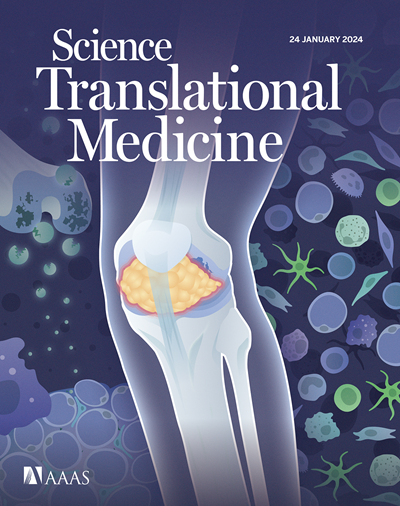Preclinical development of anti-CD21 chimeric antigen receptor T cells to treat T cell acute lymphoblastic leukemia
IF 15.8
1区 医学
Q1 CELL BIOLOGY
引用次数: 0
Abstract
Patients with relapsed/refractory (r/r) T cell acute lymphoblastic leukemia (T-ALL) have a dismal prognosis, highlighting the urgent need for effective therapies. Chimeric antigen receptor (CAR)–T cell approaches targeting pan–T cell antigens may be limited by T cell aplasia and fratricide, necessitating “rescue” allogeneic hematopoietic stem cell transplantation. In this study, we identify CD21, a pan–B cell marker, as a promising target for T-ALL immunotherapy. CD21 is expressed in 50% of T-ALL cases at diagnosis but in fewer than 10% of mature T cells. We observed that CAR-T cells targeting membrane-distal CD21 epitopes were ineffective, likely because of the bulky, glycosylated nature of the antigen. However, when we engineered CAR-T cells to target membrane-proximal CD21 epitopes using an antigen-binding fragment (Fab)–CAR design, we demonstrated robust activity against T-ALL cell lines, primary tumors, and patient-derived xenografts in both in vitro and in vivo models. The enhanced efficacy of this Fab-CAR design was driven by its high stability and reduced surface expression, addressing limitations of traditional CAR constructs. In addition, pharmacological inhibition of the phosphatidylinositol 3-kinase axis up-regulated CD21 expression in T-ALL, further enhancing the potency of anti-CD21 CAR-T cells in vitro and in a patient-derived xenograft in vivo model. This study establishes CD21 as a viable CAR-T target and highlights advances in CAR design for bulky antigens, as well as the potential for pharmacological strategies to augment target expression. Anti-CD21 CAR-T cells represent a promising therapeutic option for improving outcomes for patients with T-ALL.
抗cd21嵌合抗原受体T细胞治疗T细胞急性淋巴细胞白血病的临床前研究
复发/难治性(r/r) T细胞急性淋巴细胞白血病(T- all)患者预后不佳,迫切需要有效的治疗方法。嵌合抗原受体(CAR) -T细胞靶向泛T细胞抗原的方法可能受到T细胞发育不全和自相残杀的限制,需要“抢救”同种异体造血干细胞移植。在这项研究中,我们确定了CD21,一个泛b细胞标记物,作为T-ALL免疫治疗的一个有希望的靶点。CD21在50%的T- all确诊病例中表达,但在成熟T细胞中表达的不到10%。我们观察到靶向膜远端CD21表位的CAR-T细胞是无效的,可能是因为抗原的体积大,糖基化的性质。然而,当我们使用抗原结合片段(Fab) -CAR设计设计CAR-T细胞靶向膜近端CD21表位时,我们在体外和体内模型中都证明了对T-ALL细胞系、原发肿瘤和患者来源的异种移植物的强大活性。这种Fab-CAR设计的增强功效是由于其高稳定性和减少表面表达,解决了传统CAR结构的局限性。此外,磷脂酰肌醇3-激酶轴的药理抑制上调了T-ALL中CD21的表达,进一步增强了体外和患者来源的异种移植体内模型中抗CD21 CAR-T细胞的效力。本研究确立了CD21作为一种可行的CAR- t靶点,并强调了针对大体积抗原的CAR- t设计的进展,以及增强靶点表达的药理学策略的潜力。抗cd21 CAR-T细胞是改善T-ALL患者预后的一种有希望的治疗选择。
本文章由计算机程序翻译,如有差异,请以英文原文为准。
求助全文
约1分钟内获得全文
求助全文
来源期刊

Science Translational Medicine
CELL BIOLOGY-MEDICINE, RESEARCH & EXPERIMENTAL
CiteScore
26.70
自引率
1.20%
发文量
309
审稿时长
1.7 months
期刊介绍:
Science Translational Medicine is an online journal that focuses on publishing research at the intersection of science, engineering, and medicine. The goal of the journal is to promote human health by providing a platform for researchers from various disciplines to communicate their latest advancements in biomedical, translational, and clinical research.
The journal aims to address the slow translation of scientific knowledge into effective treatments and health measures. It publishes articles that fill the knowledge gaps between preclinical research and medical applications, with a focus on accelerating the translation of knowledge into new ways of preventing, diagnosing, and treating human diseases.
The scope of Science Translational Medicine includes various areas such as cardiovascular disease, immunology/vaccines, metabolism/diabetes/obesity, neuroscience/neurology/psychiatry, cancer, infectious diseases, policy, behavior, bioengineering, chemical genomics/drug discovery, imaging, applied physical sciences, medical nanotechnology, drug delivery, biomarkers, gene therapy/regenerative medicine, toxicology and pharmacokinetics, data mining, cell culture, animal and human studies, medical informatics, and other interdisciplinary approaches to medicine.
The target audience of the journal includes researchers and management in academia, government, and the biotechnology and pharmaceutical industries. It is also relevant to physician scientists, regulators, policy makers, investors, business developers, and funding agencies.
 求助内容:
求助内容: 应助结果提醒方式:
应助结果提醒方式:


